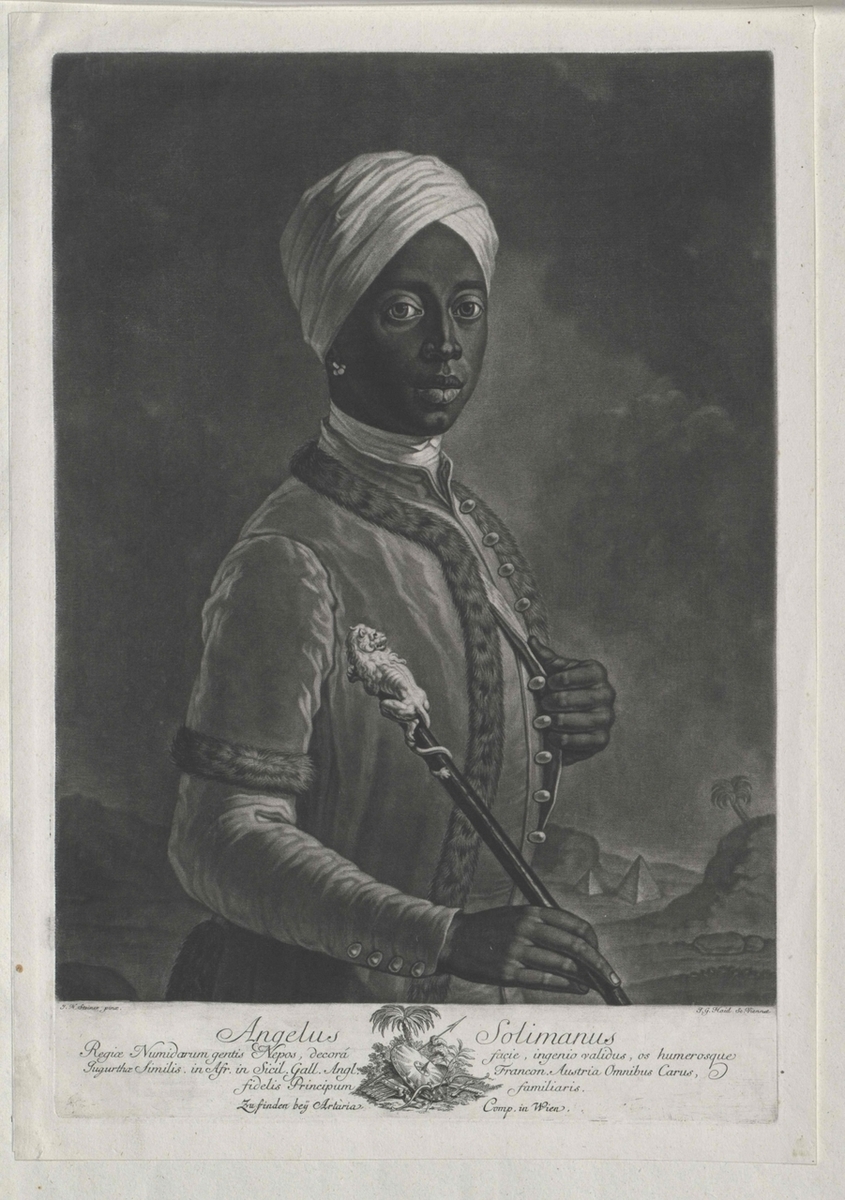Portrait of Angelo Soliman (c. 1750)
Abstract
This mezzotint depicts Angelo Soliman (c. 1720/21–1796), an enslaved African who resided at the Imperial court in Vienna. During his lifetime, Soliman was a respected personality in Viennese society and a member of the Masonic Lodge known as True Concord [Zur wahren Eintracht]. Although the portrait depicts him accordingly as an elegant, dignified figure, certain Orientalist elements, such as the turban and the Egyptian landscape, point toward his “exotic” African background. After his death, Soliman was skinned, stuffed, and added to the Imperial Cabinet of Natural Curiosities [Hof-Naturalienkabinett], where he was presented as a curiosity, a “noble savage.” His dead body was dressed in a loincloth and adorned with a feathered crown and a necklace made of shells. Mezzotint by J.G. Haid after a painting by Johann Neopomuk Steiner, Austrian National Library, see complete source citation below.
Source
Nineteenth-Century Description of the Angelo Soliman “Exhibit” in the Imperial Royal Cabinet of Natural Curiosities [Hof-Naturalienkabinett] in Vienna (1868)
[ . . . ]
The fourth room contained only a single landscape, which represented a tropical forest with underbrush, pools of water, and reeds. It included a capybara, a tapir, several white-lipped peccaries, and many swamp birds and songbirds grouped in various ways.
In the same room to the left of the exit, from which a long corridor led into the library and through it back to the main stairway, there was a glass cabinet painted with green oil paint in the corner. Its door, which formed the front wall of the cabinet, was covered with a curtain of green taffeta, and the inside of the cabinet was painted bright red. Stored in this cabinet was Angelo Soliman. Before members of the visiting public left that part of the room, an attendant would gesture toward him. Angelo Soliman was posed in a standing position, his right foot pulled back and his left hand stretched forward, with a feather belt girding his loins and a feather crown on his head, both of alternating red, white, and blue ostrich feathers in a row. His arms and legs were adorned with strings of white glass beads, and a wide, delicately woven necklace of yellowish-white money cowries (Cypraea moneta) hung way down to his chest.
[ . . . ]
Source: Leop. Jos. Fitzinger, Geschichte des kais. kön. Hof-Naturalien-Cabinetes zu Wien. II. Abtheilung. Periode unter Franz II (Franz I. Kaiser von Österreich) bis zu Ende des Jahres 1815. Aus dem LWII. Bde. der kaiserl. Akademie der Wissenschaften. I. Abth. Mai Heft Jahrgang 1868, pp. 12–13; reprinted in Philipp Blom and Wolfgang Kos, eds., Angelo Soliman. Ein Afrikaner in Wien. Vienna: Brandstatter, 2011, p. 116.
Translation: Kathleen Dell’Orto

Source: Portrait of Angelo Soliman, half-portrait, looking right, mezzotint by Johann Gottfried Haid after a painting by Johann Neopomuk Steiner. Austrian National Library. Available online at: https://www.europeana.eu/en/item/92062/BibliographicResource_1000126021713
Further Reading
“Angelo Soliman,” Black Central Europe, https://blackcentraleurope.com/sources/1750-1850/angelo-soliman-ca-1750/ (last accessed July 22, 2020)
“Angelo Soliman,” The World of the Habsburgs, https://www.habsburger.net/en/chapter/angelo-soliman (last accessed: July 22, 2020)